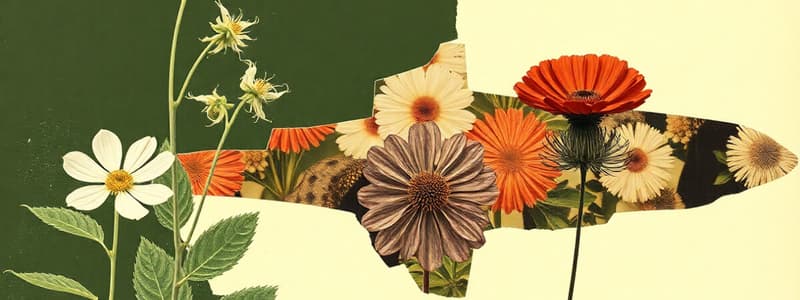Podcast
Questions and Answers
What role do plants play in bio-remediation?
What role do plants play in bio-remediation?
- They consume minerals from the soil.
- They generate toxic byproducts.
- They absorb and mitigate pollutants. (correct)
- They increase water contamination.
Which benefit attributed to plants can help improve human mental health?
Which benefit attributed to plants can help improve human mental health?
- Promotion of social isolation.
- Contribution to ecosystem degradation.
- Reduction of carbon sinks.
- Enhancement of food quality. (correct)
How do plants contribute to energy resources?
How do plants contribute to energy resources?
- By generating electricity via photosynthesis.
- Through the production of oil, sugars, and wood. (correct)
- By providing synthetic fuels.
- By storing carbon in concrete.
What is one example of how vegetation benefits public health?
What is one example of how vegetation benefits public health?
Which aspect highlights the relevance of studying plants in addressing societal challenges?
Which aspect highlights the relevance of studying plants in addressing societal challenges?
What is the primary reason for studying plant structure?
What is the primary reason for studying plant structure?
Which of the following structures is specifically associated with lipid metabolism?
Which of the following structures is specifically associated with lipid metabolism?
Which aspect does NOT describe the relationship between structure and function in plants?
Which aspect does NOT describe the relationship between structure and function in plants?
Who is recognized as the father of botany for developing a taxonomy of plants?
Who is recognized as the father of botany for developing a taxonomy of plants?
What role do thin elongate structures play in plants?
What role do thin elongate structures play in plants?
What type of tissue is located just behind the epidermis in a stem?
What type of tissue is located just behind the epidermis in a stem?
Which type of sclerenchyma is found in mature tissue?
Which type of sclerenchyma is found in mature tissue?
Which root system consists of a main taproot with smaller lateral roots?
Which root system consists of a main taproot with smaller lateral roots?
What is the primary function of adventitious roots in mangroves?
What is the primary function of adventitious roots in mangroves?
Where does photosynthesis occur in plants besides the leaves?
Where does photosynthesis occur in plants besides the leaves?
What is the role of the pith within the stem structure?
What is the role of the pith within the stem structure?
Which type of root is specifically designed for climbing support?
Which type of root is specifically designed for climbing support?
Which characteristic differentiates collenchyma from sclerenchyma?
Which characteristic differentiates collenchyma from sclerenchyma?
What is the role of cork cambium in secondary growth?
What is the role of cork cambium in secondary growth?
What constitutes the bark of a tree?
What constitutes the bark of a tree?
What is the consequence of removing bark from a woody plant?
What is the consequence of removing bark from a woody plant?
What happens to the epidermis during secondary growth?
What happens to the epidermis during secondary growth?
What is meant by 'girdling' in terms of plant physiology?
What is meant by 'girdling' in terms of plant physiology?
What key challenges are associated with studying plants?
What key challenges are associated with studying plants?
Which botanical garden is recognized as the world's oldest academic garden?
Which botanical garden is recognized as the world's oldest academic garden?
What vitamin is highlighted for its significance in plant studies related to medicine?
What vitamin is highlighted for its significance in plant studies related to medicine?
What was De Materia Medica primarily about?
What was De Materia Medica primarily about?
When did Dioscorides write his influential work on plants?
When did Dioscorides write his influential work on plants?
What is a major reason to study plants according to the content?
What is a major reason to study plants according to the content?
Which of the following is NOT listed as a challenge related to plants?
Which of the following is NOT listed as a challenge related to plants?
What health issue is associated with Vitamin C deficiency?
What health issue is associated with Vitamin C deficiency?
What was the focus of Culpeper's work in the 17th century?
What was the focus of Culpeper's work in the 17th century?
Which four crops are responsible for nearly two-thirds of global agricultural calories?
Which four crops are responsible for nearly two-thirds of global agricultural calories?
What is the rate at which crop yields for maize is increasing per year?
What is the rate at which crop yields for maize is increasing per year?
By what percentage must global food production increase to meet future demands by 2050?
By what percentage must global food production increase to meet future demands by 2050?
What does biomimicry refer to in the context of studying plants?
What does biomimicry refer to in the context of studying plants?
What is one way that climate change is projected to affect crop yields?
What is one way that climate change is projected to affect crop yields?
Which of the following is NOT a reason for studying plants?
Which of the following is NOT a reason for studying plants?
Which material is identified as a component of bottles related to plant study?
Which material is identified as a component of bottles related to plant study?
Flashcards
Why study plants?
Why study plants?
The study of plants is essential for addressing critical global challenges such as climate change, resource sustainability, food security, biodiversity conservation, and pollution mitigation.
Phytochemicals and medicine
Phytochemicals and medicine
Plants produce a vast array of chemicals, some of which have medicinal properties. One example is vitamin C, also known as ascorbate.
Scurvy
Scurvy
Scurvy is a disease caused by vitamin C deficiency. It affects the body's ability to produce collagen, leading to weakness, fatigue, and bleeding gums.
Orto Botanico di Padova
Orto Botanico di Padova
Signup and view all the flashcards
Dioscorides
Dioscorides
Signup and view all the flashcards
De Materia Medica
De Materia Medica
Signup and view all the flashcards
Plants and global challenges
Plants and global challenges
Signup and view all the flashcards
Why are plants relevant?
Why are plants relevant?
Signup and view all the flashcards
Phytochemicals
Phytochemicals
Signup and view all the flashcards
Food Source
Food Source
Signup and view all the flashcards
Material Source
Material Source
Signup and view all the flashcards
Bio-remediation
Bio-remediation
Signup and view all the flashcards
Carbon Sink
Carbon Sink
Signup and view all the flashcards
Phytochemistry
Phytochemistry
Signup and view all the flashcards
Nicholas Culpeper
Nicholas Culpeper
Signup and view all the flashcards
Four Global Crops
Four Global Crops
Signup and view all the flashcards
Materials from Plants
Materials from Plants
Signup and view all the flashcards
Biomimicry
Biomimicry
Signup and view all the flashcards
Plant-based Energy
Plant-based Energy
Signup and view all the flashcards
Food from Plants
Food from Plants
Signup and view all the flashcards
Population Growth and Food Demand
Population Growth and Food Demand
Signup and view all the flashcards
Structure-Function Relationship in Plants
Structure-Function Relationship in Plants
Signup and view all the flashcards
Examples of Structure-Function
Examples of Structure-Function
Signup and view all the flashcards
Why a Leaf Has a Large Surface Area
Why a Leaf Has a Large Surface Area
Signup and view all the flashcards
Why a Root Is Thin and Elongated
Why a Root Is Thin and Elongated
Signup and view all the flashcards
Why is Studying Plant Structure Important?
Why is Studying Plant Structure Important?
Signup and view all the flashcards
Bark
Bark
Signup and view all the flashcards
Periderm
Periderm
Signup and view all the flashcards
Cork Cambium
Cork Cambium
Signup and view all the flashcards
Secondary growth
Secondary growth
Signup and view all the flashcards
Girdling (or bark ringing)
Girdling (or bark ringing)
Signup and view all the flashcards
Epidermis (stem)
Epidermis (stem)
Signup and view all the flashcards
Ground tissue (stem)
Ground tissue (stem)
Signup and view all the flashcards
Vascular tissue (stem)
Vascular tissue (stem)
Signup and view all the flashcards
Collenchyma (stem)
Collenchyma (stem)
Signup and view all the flashcards
Sclerenchyma (stem)
Sclerenchyma (stem)
Signup and view all the flashcards
Taproot
Taproot
Signup and view all the flashcards
Fibrous root system
Fibrous root system
Signup and view all the flashcards
Adventitious roots
Adventitious roots
Signup and view all the flashcards
Study Notes
Course Information
- Course title: Physiology of Plants and Animals BL1004
- Lecturer: Prof. Marcel Jansen
- Email: [email protected]
- Staff:
- Prof Marcel Jansen (Module coordinator, Plant physiology lecturer - 8 lectures)
- Prof Rob McAllen, Dr Fidelma Butler, Prof Sarah Culloty & Dr Neil Coughlan (Animal physiology lecturers - 9 lectures)
- Dr Tom Quirke (Coordinator 2 practicals, [email protected])
- Lectures: Available on Canvas
- Group 1: Biological and Chemical Sciences
- Group 2: Food Science and Technology, Nutritional Sciences, Geography and Archaeology, Biological, Earth and Environmental Sciences.
- Timetables may differ between groups
- Practical details available from Dr Tom Quirke
- Required textbook: Campbell & Reece (editions 9, 10, 11, 12...)
- PPT's on Canvas need to be annotated
- Practical Plant Physiology = 15%
- Practical Animal Physiology = 15%
- Winter MCQ exam = 70%
- Absence form needs to be completed for missed practicals. Contact [email protected] for queries
Plant Physiology - Key Concepts
- Plant blindness exists - Luke Skywalker... a look out for plants!
- Plant biomass (450 Gt Carbon) dominates Earth's total biomass (≈550 Gt), surpassing other organisms.
- Why study plants?
- Climate change
- Sustainability and resources
- Food supply
- Biodiversity
- Pollution
- Importance of plants in medicine using phytochemicals (e.g., ascorbic acid, scurvy etc)
- Ancient historical use of plants in medicine from Dioscorides to Culpeper.
- Modern use of plants for more than just food and medicine.
- Materials: fibers/polymers (bottles: 30%, clothing)
- Energy: oil, sugars, wood (wood for building)
Plants - Differences from Animals
- Plants are immobile (sessile)
- Plants have much more plasticity than animals (adjusting structure to local environment)
- Plants are totipotent (unlike animal cells), meaning all cells can develop into a new organism
Other Topics
Plant Structure
- Molecular structure of DNA, proteins, and lipids.
- Chemical composition.
- Folding/conformation.
- Cellular structure (cytology)
- Tissue structure (histology)
- Organization of tissues (forming) plant organs (e.g., root, stem, leaf).
- Whole plant structure (anatomy) and outward appearance (morphology).
- Vegetation structure (ecology). -Examples link structure - function.
Plant Tissues
- Dermal tissue (single layer epidermis)
- Vascular tissue (xylem, phloem)
- Ground tissue (Parenchyma, including meristems)
- Plant cells are totipotent
Plant Organs (three)
- Roots.
- Stems.
- Leaves
- Flowers (modifications of leaves).
Plant Growth
- Primary growth (mitosis, enlargement, differentiation)
- Lateral roots and shoots (pre-formed axillary buds)
- Secondary growth (vascular cambium, cork cambium).
- Consequences of secondary growth (bark formation, issues in girdling)
- Plant lifespan (Annual, biennial, perennial)
- Examples of long-lived plants (e.g., bristlecone pine trees, Yew trees).
Plant Interactions/ Ecosystems
- Bio-remediation
- Nitrogen fixating nodules of roots.
- Mycorrhiza (fungi-plant networks).
Important Structures
- Root (hairst, cap, lateral roots, adventitious roots).
- Stem (apex, nodes, internodes, axillary buds).
- Leaf (margins, structure, modified leaves).
Additional Useful Information
- Number of plant species (mosses, ferns, gymnosperms, angiosperms)
- Plant structures to support these functions.
- Relationship between structure and function at different levels of organization.
- Examples of plant structural plasticity.
Studying That Suits You
Use AI to generate personalized quizzes and flashcards to suit your learning preferences.




